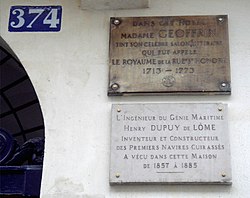Rue Saint-Honoré
Coordinates: 48 ° 52 ' N , 2 ° 20' E
| Rue Saint-Honoré | |
|---|---|
| location | |
| Arrondissement | 1. 8. |
| quarter | Halles Palais-Royal Place-Vendôme Madeleine |
| Beginning | 21, rue des Halles |
| The End | 14, Rue Royale |
| morphology | |
| length | 1840 m |
| width | 20 m except in 2 places: 17.50 and 14.60 m |
| history | |
| Original names | Rue du Chastiau Festu Rue du Château Fêtu Rue de la Chausseterie Rue de la Croix-du-Tirouer Rue de la Croix-du-Tiroir Rue du Traihoir Rue du Traihouer Rue du Trayoir Rue du Trahoir Rue du Triouer Rue du Trioir Rue de la Chaussée Saint-Honoré Chemin de Clichy Grand chemin Saint-Honoré Chaussée Saint-Honoré Grand chemin de la porte Saint-Honoré Chemin Royal Nouvelle rue Saint-Louis Grand'rue Saint-Louis Rue Neuve Saint-Louis Grande rue du Faubourg Saint-Honoré Chaussée Saint -Honoré Rue Neuve Saint-Honoré |
| Hist. Surname | Chemin du Roule |
| Coding | |
| Paris | 8860 |
The Rue Saint-Honoré in Paris is one of the oldest streets in the city. It runs parallel to the Rue de Rivoli .
course
Rue Saint-Honoré begins at Rue des Halles 21, crosses the 1st arrondissement and the 8th arrondissement
- the Quartier des Halles (No. 33 to 149 and 2 to 170)
- the Quartier du Palais-Royal (numbers 151 to 197 and 182 to 296)
- the Quartier de la Place Vendôme (nos. 199 to 271 and 298 to 404)
- the Quartier de la Madeleine (numbers 273 to 283 and 408 to 422)
and ends after 1840 meters at 14 Rue Royale .
At its eastern end it merges into Rue des Halles and its western end into Rue du Faubourg Saint-Honoré , making it the only locally important road north of the Seine to Saint-Ouen and Argenteuil , before it was decided by Napoleon ( 1801) was replaced by Rue de Rivoli (as part of the Grande Ax ) a few meters further south.
The rue Saint-Honoré mainly crosses its 1.8 kilometers
- the rue du Louvre
- the avenue de l'Opéra
- the rue de Castiglione (which leads to the Place Vendôme )
Rue Saint-Honoré takes its name from the collegiate church of Saint-Honoré and the monastery of Saint-Honoré , which were located between Rue Jean-Jacques Rousseau and Rue des Bons Enfants.
history

The Rue Saint-Honoré was originally an easy route to Saint-Ouen , Argenteuil , Le Roule and Neuilly-sur-Seine , and (due to the course of the Seine) had no national significance. Only in the 12th century, after the halls were set up, did their development begin. It extended the Rue de la Ferronerie to the west and ended at the Porte Sainte-Honoré (the old or the new), then from 1634 at the Rue Royale. In the past it had the following names:
- Between the Rue de la Lingerie and the Rue de la Tonnellerie, it was called Rue de la Chausseterie from 1300 to the 17th century.
- Between the Rue de la Tonnellerie and the Rue de l'Arbre Sec, it was called Rue du Chastieu Festu (1300) or Rue du Château Fêtu.
- Between the Rue de l'Arbre Sec and the Rue du Rempart (no longer existent) it was called in the 13th and 14th centuries
- Rue de la Croix du Trahoir / Tiroir
- Rue du Traihoir / Traihouer / Trayoir / Trahoir / Triouer / Trioir.
In 1450 it was called Rue de la Chaussée Saint-Honoré.
- Between the Rue du Rempart and the Rue Royale it was called
- Chemin de Clichy (1204)
- Grand Chemin Saint-Honoré (1283)
- Chaussée Saint-Honoré (1370)
- Grand Chemin de la Porte Saint-Honoré (1392)
- Chemin Royal (1393)
- Nouvelle Rue Saint-Louis (1407)
- Grand'rue Saint-Louis (1421)
- Rue Neuve Saint-Louis (1430)
- Grand'rue du Faubourg Saint-Honoré (1609)
- Chaussée Saint-Honoré (1634)
- Rue Neuve Saint-Honoré (1638)
In 1966 the part between the Palais Royal, the Théâtre Français and the Place André Malraux was renamed Place Colette .
Buildings on rue Saint-Honoré

- (no longer existent) The south side of the halls between the Rue de la Lingerie and the Rue de la Tonnellerie
- (no longer exists) Molière's birthplace (no.90)
- (no longer existent) The old Porte Sainte-Honoré (No. 111), also called Porte aux Aveugles (Blind Gate, see below)
- Fontaine de la Croix du Trahoir (No. 111)
- Temple Protestant de l'Oratoire du Louvre (No. 145)
- Remains of the city wall of Philip Augustus (No. 146, 148, 150)
- The Quinze-Vingts (later relocated) home for the blind (on the south side of Place Colette)
- (no longer exists) The new Porte Saint-Honoré (No. 161)
- Café de la Régence (No. 161)
- (no longer existing) The Saint-Honoré church (between rue Croix des Petits-Champs and rue des Bons-Enfants)
- Palais Royal (No. 204) and Comédie-Française
- Hôtel Pussort, replaced in 1715 by the Hôtel de Noailles, later Hôtel de Bertin (No. 211), the remains are now integrated into the Hôtel Saint-James et Albany
- Eglise de l'Assomption (No. 263, 265)
- Eglise Saint-Roch (No. 284)
- (no longer exists) The Jacobins monastery (no. 328) that during the revolution the club of the Jacobins was home.
- Hôtel Vendôme (No. 360/364)

